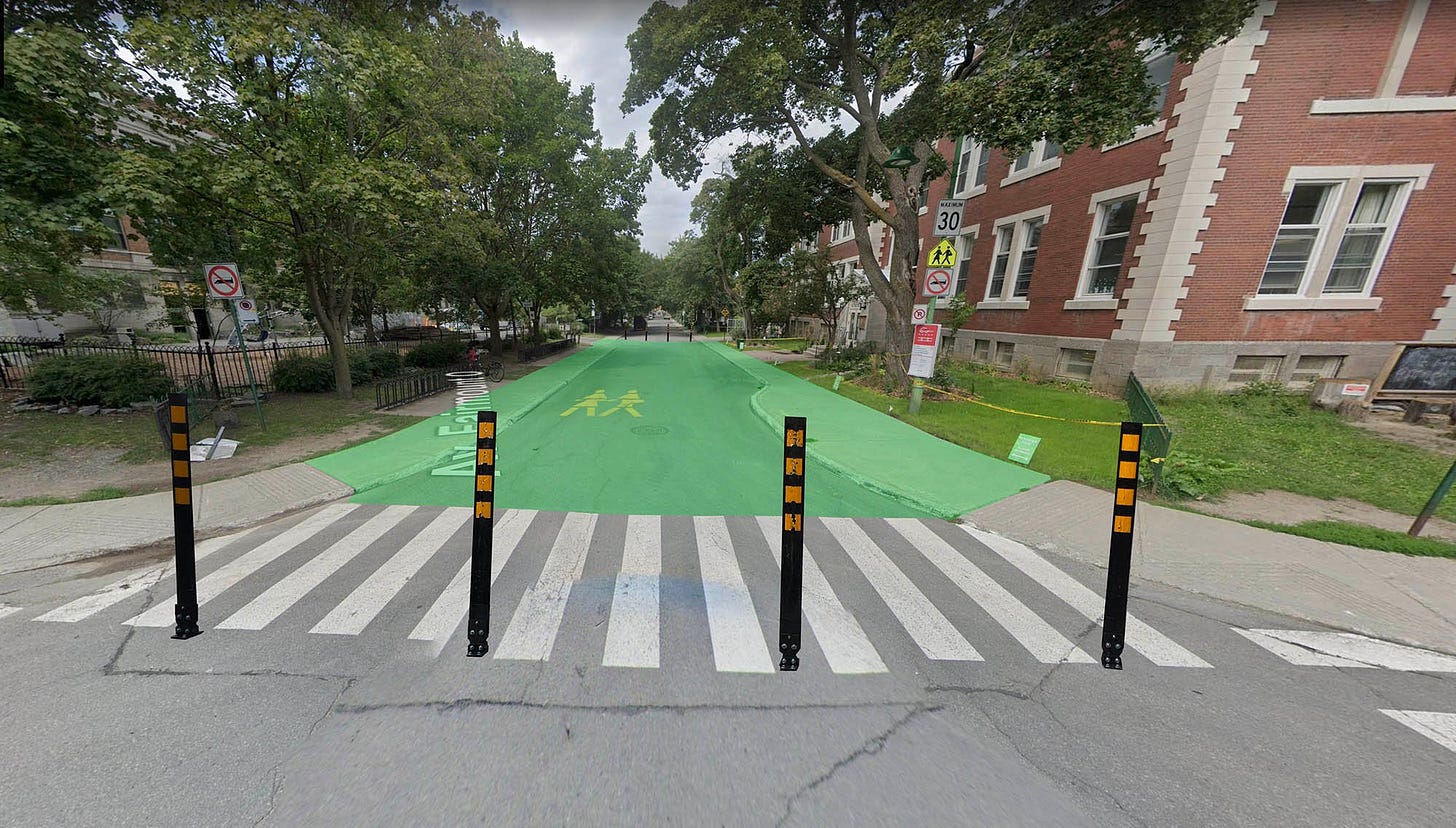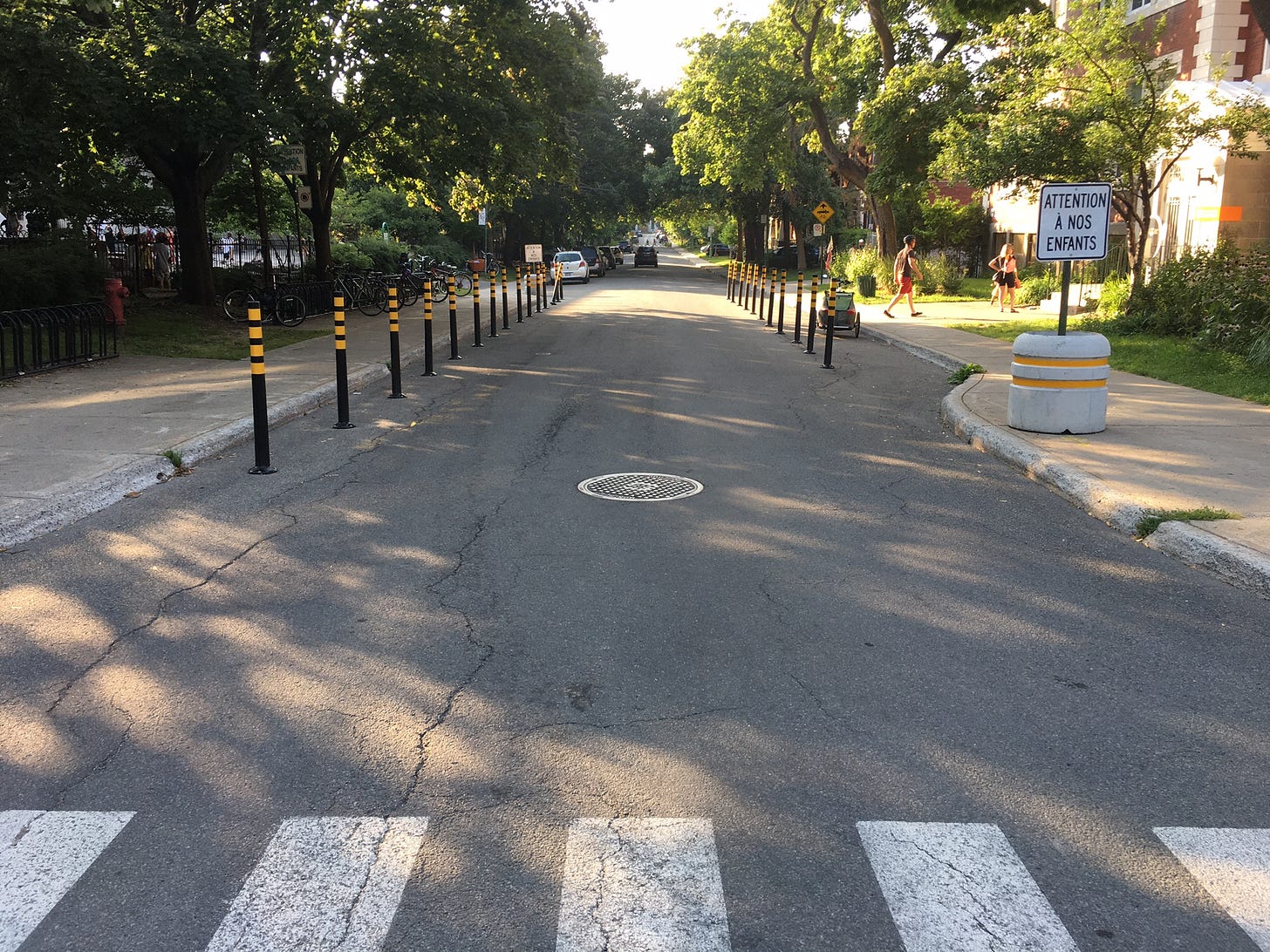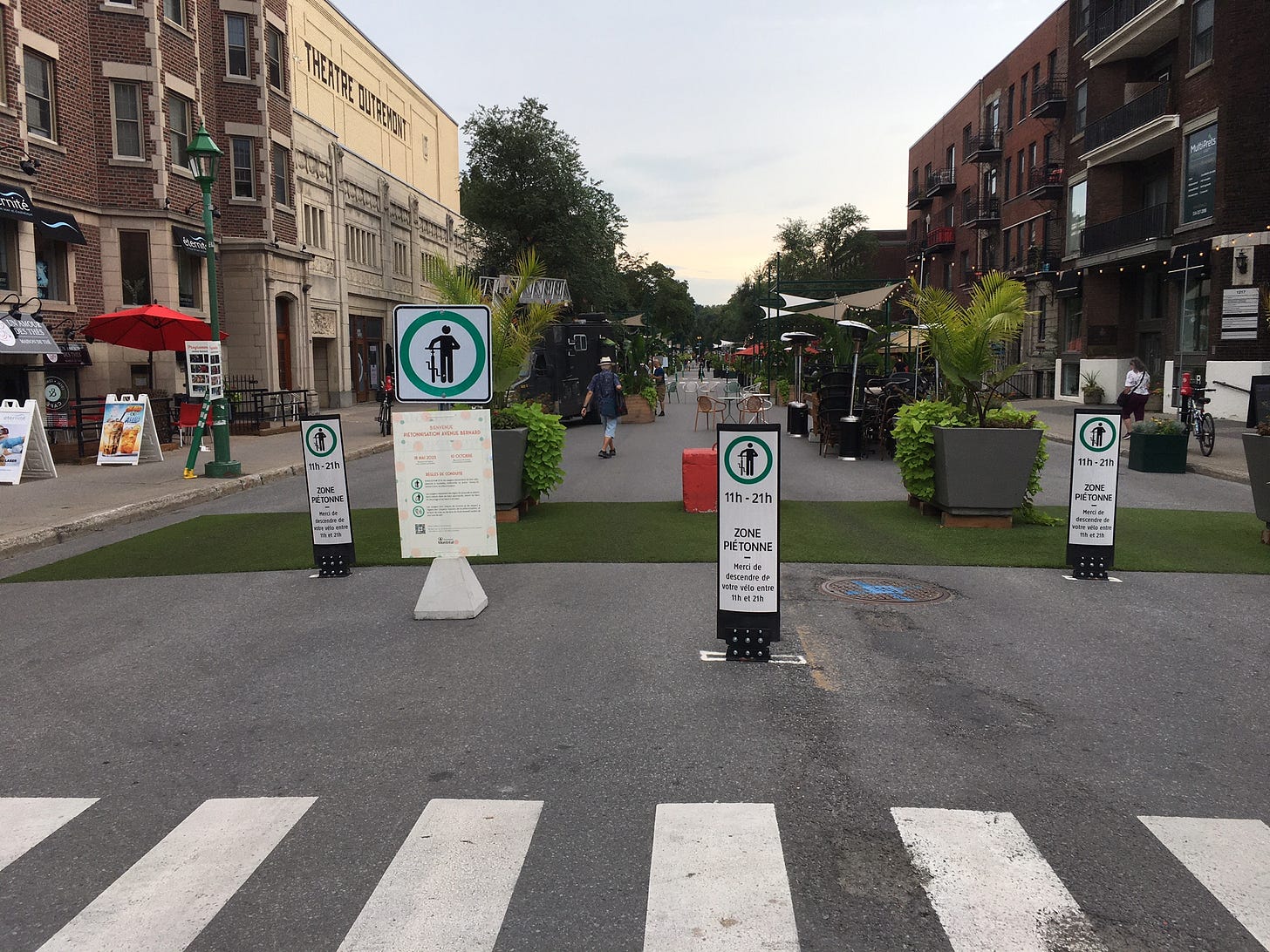It’s easy to get people to agree that our cities would be less polluted, more pleasant, and safer—for the elderly, for kids, for everyone—if we relied less on cars.
It’s equally easy to get them to acknowledge that we should be encouraging children to get more exercise by walking or riding their bicycles to school.

What’s hard—really hard—is to get anybody to do anything concrete about it. When it comes to removing parking, or closing streets to cars, lofty statements of good intentions too often vanish into the (increasingly smog- and smoke-filled) air.
That’s the experience I’m having with my children’s public elementary school in Canada’s second largest city. Montreal’s mayor is Valerie Plante, whose party Projet Montréal has done a lot to close streets to traffic, green alleys, and expand pedestrian and bicycle infrastructure. (I argue in this dispatch that they’ve fallen short on the transit file, especially given their role in killing the REM de l’Est, which would have provided a crucial light-metro route to the city’s east end.) Last week, just in time for la rentrée (back-to-school) Plante announced $10 million for making the streets around schools safer.
I should be rejoicing. But I’m not. Here’s why.
Last year, I joined several parents in organizing an “Active Transport” committee at our children’s school, which is located in the borough known as Outremont. (Here’s our Facebook page; I invite you to visit, we love, and need, your “Likes.”) The school’s playground and main entrance are located on a relatively quiet one-way street. On the other side of the street is a private elementary school; many of the parents there drive in from outside the district. In the morning, around 8:30, the street becomes a dangerous corridor of distracted, car-driving parents jostling for space to drop off their kids. Some park on the sidewalk, or in the crosswalks (the goal of many seems to be to get as close as possible to the entrance, and walk as little as possible). Yet there’s a public parking lot, free in the morning, with lots of spaces, located just one short block away the school.
My two boys have always walked or ridden their bikes to school. Over the years, they’ve experienced a lot of near misses (some of them bad enough to have added grey hairs to my head). We’ve seen fender-benders, but happily, no children have been injured—though last year, Maria, a 7-year-old refugee recently arrived from Ukraine, was run over and killed by a car as she was walking to school in another Montreal borough. (I also wrote about the issue in a dispatch earlier this year, “The Case for Car-Free School-Streets.”)
Last spring, the students at our school held an enthusiastic demonstration in the playground, asking for safer streets around the school. The committee conducted a survey of parents, and found that the majority lived within two kilometers of the school, and were in favor of limiting traffic in the surrounding streets.
During the end-of-year school fair, we set up a table presenting the project and asking for input; we were gratified to see the borough mayor, as well as some councillors, come by and tell us that the political will was there, and they were committed to moving the file forward. In the last week of school, we set up a trial run, closing several streets around the school early in the afternoon. The experiment showed that closing multiple streets was complicated, and that we’d be better off focussing our efforts on that one, really dangerous section of road—the couple of hundred metres between our public school and the private one across the street.
Below is a rendering of what the committee asked for over the summer: a complete closure of the street for half an hour to 45 minutes on weekday mornings. Part of the street—the danger zone where kids enter and exit the playground—would be painted green to indicate it was closed to cars. Flexible, removable bollards would be placed in front of the crosswalk. They would allow emergency and service vehicles, as well as delivery trucks, to pass easily (even cars can drive over the bollards; they just snap back into place). The alternative would be a metal barrier blocking the street, which could be moved into and out of position at either end of the morning rush.
We came back from summer vacation with high hopes. In Europe, the movement to create “School Streets” is spreading; London has dozens, and Paris now counts close to 200 “Rue-aux-Écoles,” closed to traffic. We were hoping the momentum might have carried over to the world’s second-largest French-speaking city.
Here’s what we found: instead of barriers blocking the street, the borough had set up a line of flexible bollards on either side. They put some concrete “cloches,” or bells, near the crosswalks, to prevent people from parking there. And they erected a sign: “Attention à Nos Enfants” (Watch Out for Our Children.)
Problem sorted, right? Wrong. Though the bollards have removed some parking/stopping spaces, cars and trucks still enter the street. It’s an improvement, but not what we were looking for. And it’s typical of the half-measures that pass for reform when it comes to changing the car-dominated status quo in cities in Canada and the U.S.
I went to the monthly borough meeting this week to ask about progress on the file. The meeting started with an opposition councillor raising the fact that Mayor Plante had made millions available to make streets around schools more secure, and pointing out that the borough of Outremont hadn’t put forth any projects to take advantage of these funds. The mayor of the borough started with good news: the speed limit on several streets, he said, was being lowered to 20 km/h. He also noted there were 15 schools in the borough. And that, he said, made things very, very complicated.
I reminded the council that our school had requested help in setting up a school street, and that we wanted to do everything we could to make this happen in the near future. I also pointed out that lowering the speed limit only works if you enforce the limit. (I have yet to see a speeding ticket issued by a police car in any of the streets around the school; nor are there any speed cameras to automatically issue tickets.) The councillor responsible for the file, who is also a parent at our school, told me that an engineer had to sign off on the plans, and getting them to do so was costly. I pointed out that they had engineers on staff, and now there were those millions of dollars available from the municipal government to support such projects. She finished with the now familiar refrain: “C’est pas simple.” It’s not easy.
I submit that, if the political will is there—as it appears to be in Paris and London—this kind of thing is easy. In fact, unstoppably easy.
Interestingly, the borough of Outremont completely closes a section of a major commercial thoroughfare, Avenue Bernard, to automobile traffic. Not just for half an hour in the morning, but 24/7, all through the summer. People sit out on the street, playing chess with giant pieces, eating ice cream cones, watching the world go by. Restaurant owners love the street closure—in fact, they now demand it, as their business booms as clients occupy scores of tables on the asphalt.
I bet that wasn’t at all simple to organize. Bernard is a major, borough-crossing street, and closing it is a big deal. But because the business-owners discovered the closure was really, really good for business, all the stops were removed (or more precisely, put in place) to keep it happening.
What we’re asking is the closure of a small street, for less than an hour on weekday mornings—not to sell ice cream (not there’s nothing wrong with ice cream!), but to keep our kids healthy and safe.
We’re going to continue the dialogue with the borough, and will continue to work for change. I don’t doubt that the process will prove…complicated.
But then again, the really important things in life always are.








Speaking from the municipal side of things, "c'est pas simple" could mean a number of things:
- There isn't a consensus on the council to do it
- There isn't "acceptabilité sociale" (meaning the 10 citizens who complain about everything will recruit 20 other citizens to complain even louder and make council sessions long and painful)
- Some higher level of government will not let us do it (often related to engineering standards set down by the Ministère des Transports)
But it could also mean one specific thing:
- We don't have enough employees to do this, or to do this would involve paying lots of overtime
This is likely why in your case Fairmount cannot be closed for a few minutes twice a day (have to send someone to put up and take down the bollards) whereas Bernard can be closed for a few months (set it and forget it).
Just speculation on my part of course!